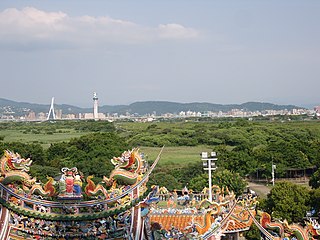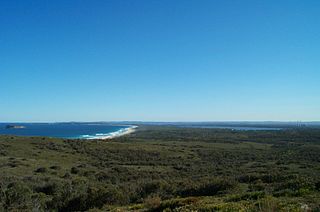Related Research Articles
Mebbin is a national park located in New South Wales, Australia, 633 kilometres (393 mi) north of Sydney. It is part of the Shield Volcano Group of the World Heritage Site Gondwana Rainforests of Australia inscribed in 1983 and added to the Australian National Heritage List in 2007. It is also part of the Scenic Rim Important Bird Area, identified as such by BirdLife International because of its importance in the conservation of several species of threatened birds.

Wollumbin National Park is a national park located in northern New South Wales, Australia, 642 kilometres (399 mi) north of Sydney near the border with the state of Queensland. It surrounds Mount Warning, part of a remnant caldera of a much larger extinct volcano. The park is administered by the NSW National Parks and Wildlife Service. The park is part of the Scenic Rim Important Bird Area, identified as such by BirdLife International because of its importance in the conservation of several species of threatened birds. In addition to numerous bird species, carpet python, land mullet, eastern small-eyed snake, lace monitor, black-bellied marsh snake and long-nosed potoroo can be found here.

Yalgorup National Park is a national park in Western Australia, 105 km south of Perth, and directly south of Mandurah
Grey Peaks is a national park in Far North Queensland, Australia, 1,374 km northwest of Brisbane. It is part of the Coastal Wet Tropics Important Bird Area, identified as such by BirdLife International because of its importance for the conservation of lowland tropical rainforest birds.

Kurrimine Beach is a national park in Queensland, Australia, which lies 1,295 km northwest of Brisbane. It is part of the Coastal Wet Tropics Important Bird Area, identified as such by BirdLife International because of its importance for the conservation of lowland tropical rainforest birds.
Maria Creek is a national park in Far North Queensland, Australia, 1292 km northwest of Brisbane. It is part of the Coastal Wet Tropics Important Bird Area, identified as such by BirdLife International because of its importance for the conservation of lowland tropical rainforest birds.

Mount Chinghee is a national park in Queensland, Australia, 93 kilometres (58 mi) south of Brisbane. It is part of the Shield Volcano Group of the World Heritage Site Gondwana Rainforests of Australia inscribed in 1986 and added to the Australian National Heritage List in 2007. It is also part of the Scenic Rim Important Bird Area, identified as such by BirdLife International because of its importance in the conservation of several species of threatened birds.
Russell River is a national park in North Queensland, Australia, 1352 km northwest of Brisbane. The park protects a coastal strip between the sea and the Russell River. It is part of the Coastal Wet Tropics Important Bird Area, identified as such by BirdLife International because of its importance for the conservation of lowland tropical rainforest birds.

The regent honeyeater is a critically endangered bird endemic to southeastern Australia. It is commonly considered a flagship species within its range, with the efforts going into its conservation having positive effects on many other species that share its habitat. Recent genetic research suggests it is closely related to the wattlebirds.

The Royal Australasian Ornithologists Union (RAOU), now part of BirdLife Australia, was Australia's largest non-government, non-profit, bird conservation organisation. It was founded in 1901 to promote the study and conservation of the native bird species of Australia and adjacent regions, making it Australia's oldest national birding association. In 1996, the organisation adopted the trading name of Birds Australia for most public purposes, while retaining its original name for legal purposes and as the publisher of its journal, the Emu. In 2012, the RAOU merged with Bird Observation & Conservation Australia to form BirdLife Australia.

An Important Bird and Biodiversity Area (IBA) is an area identified using an internationally agreed set of criteria as being globally important for the conservation of bird populations.

The Atlas of Australian Birds is a major ongoing database project initiated and managed by BirdLife Australia to map the distribution of Australia's bird species. BirdLife Australia is a not-for-profit bird research and conservation organisation.

Wingspan was the quarterly membership magazine of the Royal Australasian Ornithologists Union (RAOU). It was first issued in 1991, replacing the RAOU Newsletter. When Birds Australia and Bird Observation and Conservation Australia merged in 2012 to form BirdLife Australia, Wingspan's run ended, and was replaced with Australian Birdlife magazine.
Bird Observation & Conservation Australia (BOCA) was a club established on 12 April 1905 by members of the Royal Australasian Ornithologists Union (RAOU) in Melbourne, Victoria, as the Bird Observers Club. Although inactive for many years, in 1927 it was revived and subsequently active until the end of 2011 when it merged with Birds Australia to form BirdLife Australia. It published a quarterly journal, Australian Field Ornithology, and a quarterly newsletter, the Bird Observer. It had a cooperative relationship with the Land for Wildlife program, a voluntary conservation scheme for private land in Victoria, which was instigated by two prominent club members, Ellen McCulloch and Reg Johnson, established in 1981, and coordinated by the Victorian Department of Sustainability and Environment.
Lesley Brooker is an Australian ornithologist based in Western Australia following retirement from a career with the CSIRO's Division of Wildlife Research. There she worked, as a database manager and computer modeller, on developing methodologies for the re-design and restoration of agricultural lands for bird conservation. Since then she has collaborated with her husband Michael Brooker in studies on cuckoo evolution, population ecology of fairy-wrens and spatial dynamics of birds in fragmented landscapes. In 2004 she was awarded, jointly with her husband Michael, the Royal Australasian Ornithologists Union's D.L. Serventy Medal which recognizes excellence in published work on birds in the Australasian region.

Munmorah State Conservation Area is located on the Central Coast of New South Wales, Australia. The area's coastal setting and panoramic views, perched sand dunes, diverse vegetation communities, protected threatened species and migratory bird habitats, together with opportunities for nature based recreation and for educational and scientific study, were cited as reasons for the reserve's creation. The reserve is part of the Tuggerah Important Bird Area, identified as such by BirdLife International because of its importance for a variety of water and woodland birds.
Hen Island is an island located close to the south-western coast of Tasmania, Australia. The 7.6-hectare (0.029 sq mi) island is part of the Maatsuyker Islands Group, and comprises part of the Southwest National Park and the Tasmanian Wilderness World Heritage Site.

Round Top Island is an island located close to the south-western coast of Tasmania, Australia. The 6.25-hectare (0.0241 sq mi) island is part of the Maatsuyker Islands Group, and comprises part of the Southwest National Park and the Tasmanian Wilderness World Heritage Site.
The Spit Nature Conservation Reserve is a 300 ha nature reserve on the north-western shore of Port Phillip, a large bay in Victoria, Australia. It consists of public land set aside to conserve and protect species, communities, and habitats of indigenous plants and animals. It is adjacent to the Werribee Sewage Farm and is managed by Parks Victoria.

BirdLife Australia is a not-for-profit organisation advocating for native birds and the conservation of their habitats across Australia.
References
- ↑ "Australian Birdlife Magazine". Michael Snedic. Retrieved 12 May 2016.